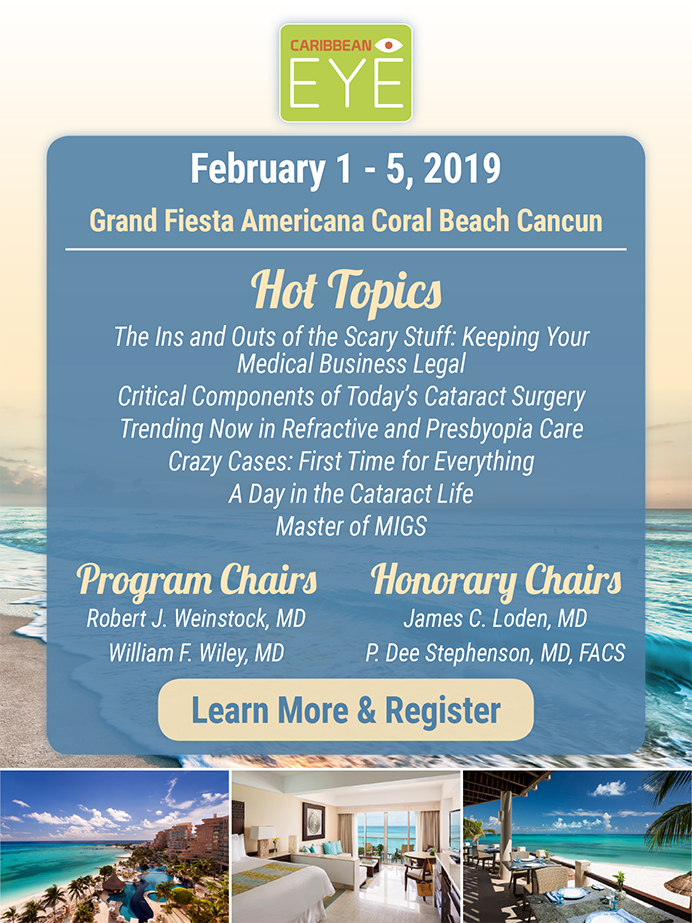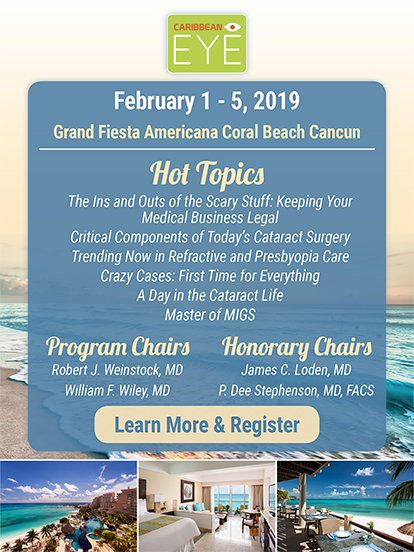Modern cataract surgery is an extraordinarily successful operation with low rates of complications. New surgical techniques and technologies, including the introduction of the femtosecond laser and the continual refinement of phacoemulsification, have the potential to further improve outcomes and reduce complications.1 After uncomplicated cataract surgery, patients follow a short course with predictable healing and low risk.
By contrast, traditional glaucoma surgeries, including trabeculectomy or tube shunts, present higher risk profiles and more variable postoperative courses. These interventions have conventionally been reserved for patients with advanced glaucoma and are generally managed by our glaucoma subspecialist colleagues.2
Recently, we have seen the introduction of multiple options for microinvasive glaucoma surgery (MIGS). These procedures allow cataract patients with concomitant glaucoma or ocular hypertension to be treated for both conditions with a single intervention while maintaining essentially the same low risk profile as cataract surgery alone. This gives us an opportunity to offer these patients a better quality of life by reducing their dependence on medications, achieving better long-term IOP control, and preventing or slowing progression of the disease.
This article explores how postoperative care differs when a MIGS procedure is added to cataract surgery. This is important information for today’s optometrists who participate in collaborative care with cataract surgeons.
AFTER CATARACT SURGERY
The postoperative course for traditional uncomplicated cataract surgery includes a combination of topical medications to guard against infection, reduce inflammation, and manage pain. Modern regimens consist of a combination of antibiotics, steroids, and NSAIDs that may be administered postoperatively via eye drops or perioperatively as part of a so-called dropless cataract surgery protocol.
Standard of care dictates a day 1 follow-up exam to confirm uncomplicated surgery and to review postoperative instructions and expectations with the patient. If the fellow eye is scheduled for surgery, at the 1- or 2-week exam the clinician will check the progress of the first surgery and qualify the second eye for its procedure.
After the patient has had the second procedure (or in the event of a unilateral procedure), a follow-up exam at 3 to 4 weeks serves as a final check of the surgery and includes postoperative refractive assessment before the normal monitoring schedule is resumed.
WHEN MIGS IS ADDED
In determining the cataract surgical and subsequent postoperative plan for a patient with concomitant glaucoma, if a MIGS procedure is to be added, the clinician should consider the risk profiles, indications, and contraindications, all of which vary among MIGS modalities.3 For example, a trabecular meshwork stenting procedure such as the iStent (Glaukos) may have a good safety profile but only modest IOP-lowering effects, whereas a subconjunctival procedure such as the Xen Gel Stent (Allergan) may be as effective as a filtering procedure but have a higher risk profile and longer postoperative course.
Other ocular considerations include the physical anatomy of a patient’s angle and the ability to position the patient so that the surgeon can adequately view and gain access to the angle in the operating room. A patient with significant corneal scarring or angle obscurations, including peripheral anterior synechiae or neovascularization of the angle, may need a different procedure.
Systemic considerations include patients taking systemic blood thinners or antiplatelet therapy, who can have higher risk of bleeding intraoperatively or postoperatively with some MIGS procedures more than others.
Another issue, given the growing number of MIGS techniques available, is whether the surgeon is proficient with the desired procedure. Likewise, the surgery center may not have the equipment needed for certain MIGS procedures, limiting the surgeon’s ability to offer that procedure.
POSTOPERATIVE CONSIDERATIONS
Postoperatively, many MIGS procedures do not change the recovery course drastically compared to cataract surgery alone. However, each postoperative assessment in unique to the specific patient and should be approached on an individual basis.
Control of postoperative inflammation and IOP are two major considerations in managing a cataract-MIGS patient. Inflammation can vary based on the procedure, and it may not be appreciably different from cataract surgery alone. This is often the case with procedures that bypass the trabecular meshwork, such as the iStent. For these patients, customary antiinflammatory protocols are generally sufficient.
On the other hand, for incisional trabecular meshwork procedures such as the Kahook Dual Blade (New World Medical), postoperative steroids should be used for a longer course. This is not necessarily because there is more inflammation, but rather to reduce the potential for angle scarring and increase the likelihood of success.
Advanced MIGS procedures that involve a subconjunctival approach require extended postoperative steroid protocols, similar to trabeculectomy.
If IOP is at or below target immediately after surgery, IOP should be monitored closely to ensure adequate control is achieved without glaucoma drops until the surgery is healed. In the event of an IOP spike in the immediate postoperative period, prostaglandin analogues should be avoided because they increase the risk of exacerbating inflammation and the potential for cystoid macular edema. If patients require an extended course of ophthalmic steroids, they should be monitored closely for IOP elevation and managed accordingly until the antiinflammatory medication is tapered.
Intraoperative and postoperative bleeding during MIGS procedures can extend the patient’s recovery period. In the event of bleeding, in addition to managing IOP, steroid treatment may be required to minimize scarring. In some cases, cycloplegic agents may be needed to prevent synechiae forming from the pupil to the anterior capsule or IOL. It may be necessary to have the patient sleep on his or her side or with the head elevated to assist with settling of any postoperative heme in the anterior chamber.
Patients with secondary glaucomas, such as pigment dispersion, pseudoexfoliation, or neovascular glaucoma, are at inherently higher risk of postoperative challenges and may require closer monitoring.
CONCLUSION
The success and proliferation of MIGS procedures that can be combined with cataract surgery has created a new niche in the glaucoma treatment paradigm, allowing safer surgical intervention at an earlier stage of disease than was previously possible. MIGS allows us to offer, in a single procedure, increased visual potential by removing the cataract and improved quality of life by decreasing dependence on eye drops, maintaining long-term IOP control, and preventing or slowing progression of glaucoma.
- Chang D. Cataract surgery complication rate: How are we doing? CRST. February 2012.
- Raviv T. A safe, effective long-term solution to concomitant glaucoma and cataract. Glaucoma Today. Insert, May/June 2018.
- Shah M. When to avoid MIGS. Glaucoma Today. March/April 2018.






